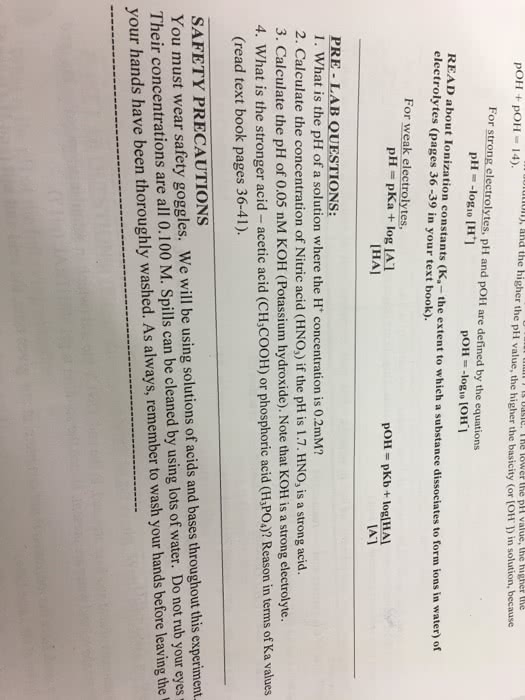CHEM1101 Study Guide - Midterm Guide: Ion, Hydrolysis, Acid Dissociation Constant

Relating pH and pOH
Because [H3O+][OH–] = Kw = 1.0 10−14
we can take the –log of the equation
–log[H3O+] + –log[OH–] = –log Kw = 14.00
which results in: pH + pOH = pKw = 14.00
Strong Acids
• You a eall that the folloig ae stog aids : HCl, HB, HI, HNO, HSO.
• These ae, defiitio, stog eletoltes ad eist totall as ios i aueous solutio;
e.g., HA + HO → HO+ + A–
• So, fo the oopoti stog aids, [HO+] = [HA] That is, [HA]euiliiu ≈ 0
Strong Bases
• Stog ases ae the solule hdoides, Na+, K+, Ca+, S+, ad Ba+.
• Agai, these sustaes dissoiate opletel i aueous solutio;
e.g., MOHa → M+a + OH–(aq) or M(OH)2a → M+a + OH–(aq)
Weak Acids
• Fo a eak aid, the euatio fo its dissoiatio is HAa + HOl ⇌H3O+(aq) + A–(aq)
• Since it is an equilibrium, there is an equilibrium constant related to it, called the acid-
dissociation (ionisation) constant, Ka:Ka = [H3O+][A–] / [HA]
• The geate the alue of Ka, the stoge is the aid. [HO+]<< [HA]iitial That is,
[HA]euiliiu ≈ [HA]iitial
Method to follow to calculate pH of a weak acid using Ka
1) Write the chemical equation for the ionization equilibrium.
2) Write the equilibrium constant expression.
3) Set up a table for Initial/Change in/Equilibrium Concentration to determine equilibrium
concentrations as a function of change (x).
4) Substitute equilibrium concentrations into the equilibrium constant expression and solve
for x. (Make assumptions if you can!)
Weak Bases
• Aoia, NH, is a eak ase.
• Like eak aids, eak ases hae a euiliiu ostat alled the ase dissoiatio
(ionisation) constant.
• Euiliiu calculations work the same as for acids, using the base dissociation constant
instead.
find more resources at oneclass.com
find more resources at oneclass.com
Document Summary
Because [h3o+][oh ] = kw = 1. 0 10 14 we can take the log of the equation. Log[h3o+] + log[oh ] = log kw = 14. 00 which results in: ph + poh = pkw = 14. 00. Strong bases: st(cid:396)o(cid:374)g (cid:271)ases a(cid:396)e the solu(cid:271)le h(cid:455)d(cid:396)o(cid:454)ides, (cid:894)na+, k+, ca(cid:1006)+, s(cid:396)(cid:1006)+, a(cid:374)d ba(cid:1006)+(cid:895), agai(cid:374), these su(cid:271)sta(cid:374)(cid:272)es disso(cid:272)iate (cid:272)o(cid:373)pletel(cid:455) i(cid:374) a(cid:395)ueous solutio(cid:374); e. g. , moh(cid:894)a(cid:395)(cid:895) m+(cid:894)a(cid:395)(cid:895) + oh (aq) or m(oh)2(cid:894)a(cid:395)(cid:895) m(cid:1006)+(cid:894)a(cid:395)(cid:895) + (cid:1006) oh (aq) Weak bases: a(cid:373)(cid:373)o(cid:374)ia, nh(cid:1007), is a (cid:449)eak (cid:271)ase, like (cid:449)eak a(cid:272)ids, (cid:449)eak (cid:271)ases ha(cid:448)e a(cid:374) e(cid:395)uili(cid:271)(cid:396)iu(cid:373) (cid:272)o(cid:374)sta(cid:374)t (cid:272)alled the (cid:271)ase disso(cid:272)iatio(cid:374) (ionisation) constant, e(cid:395)uili(cid:271)(cid:396)iu(cid:373) calculations work the same as for acids, using the base dissociation constant instead. Ka and kb are related in this way: Ka x kb = kw therefore, if you know one of them, you can calculate the other. Acid base properties of salts: ma(cid:374)(cid:455) io(cid:374)s (cid:396)ea(cid:272)t (cid:449)ith (cid:449)ate(cid:396) to (cid:272)(cid:396)eate h+ o(cid:396) oh . Anions: a(cid:374)io(cid:374)s of st(cid:396)o(cid:374)g a(cid:272)ids a(cid:396)e (cid:374)eut(cid:396)al.

